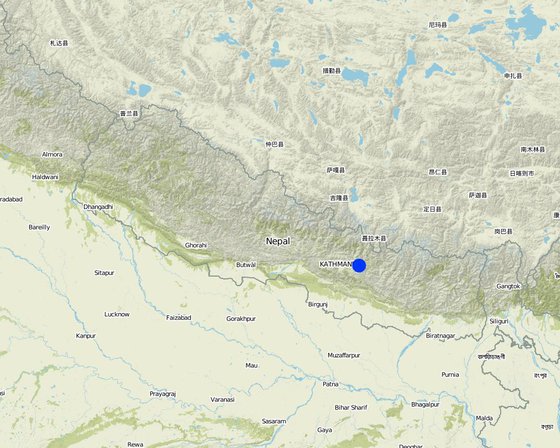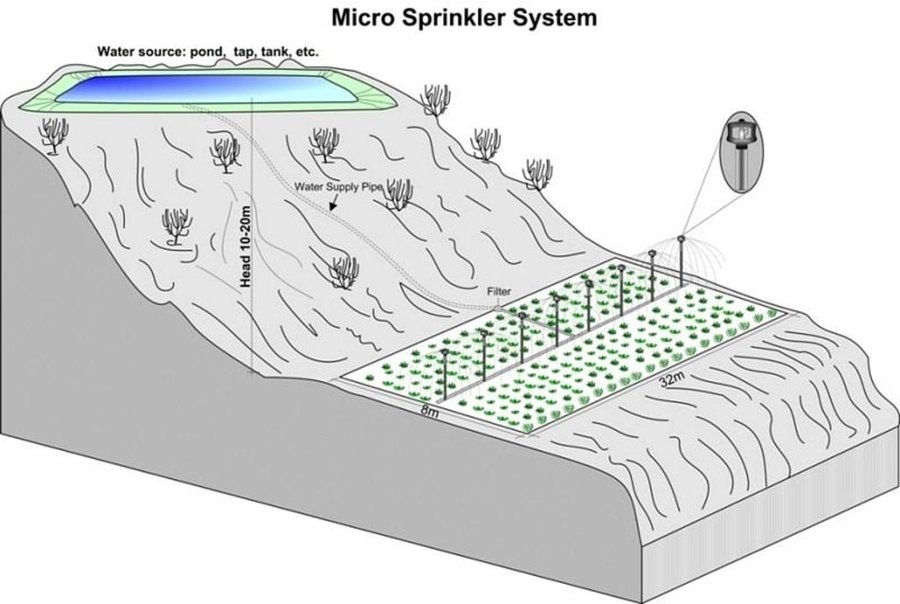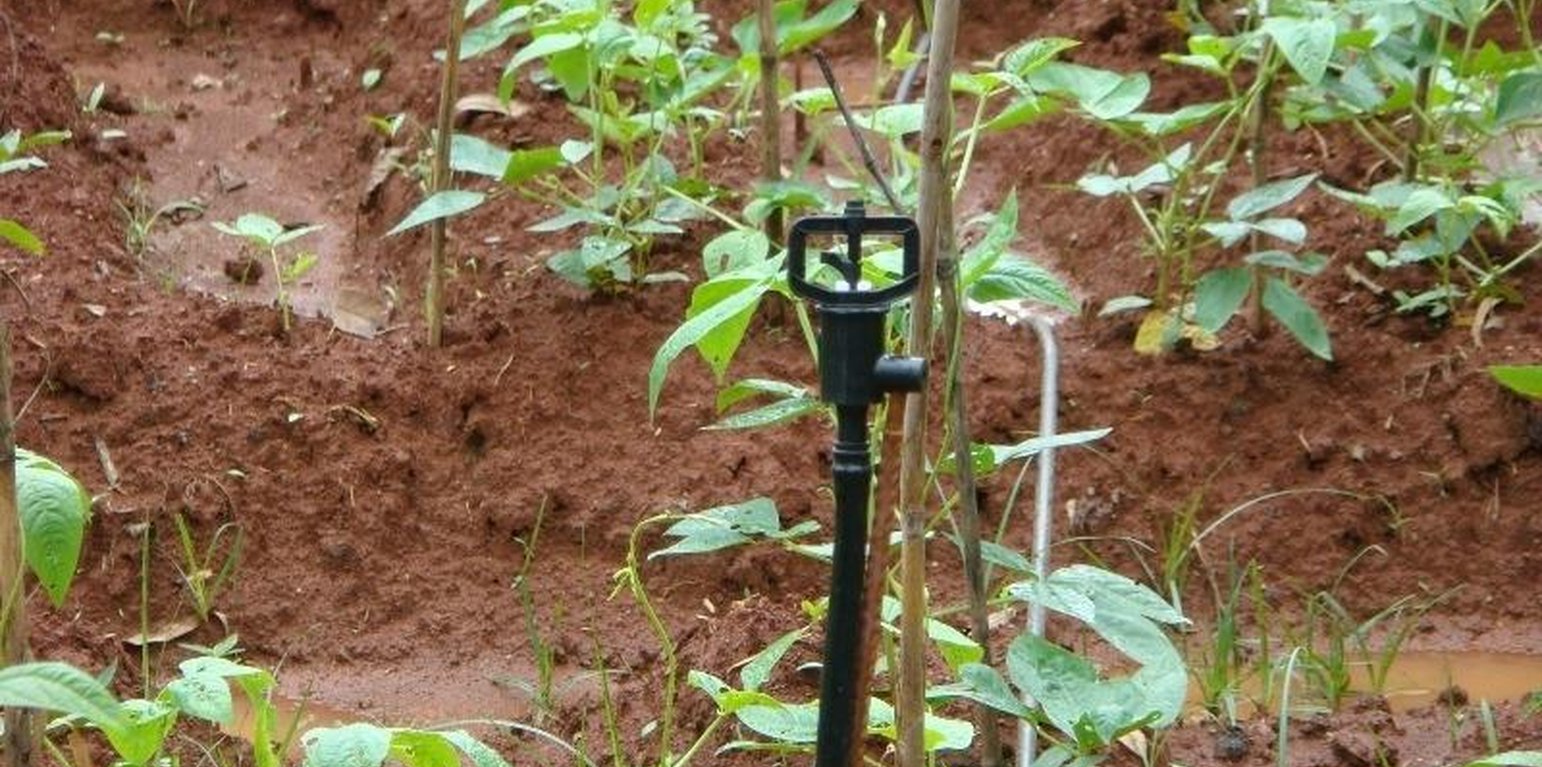Low cost micro-sprinkler irrigation
(Népal)
Phohara sinchai - Nepali
Description
An irrigation system that delivers small-sized water droplets through a rotating head allowing longer watering time with less runoff
Micro-sprinkler irrigation is an efficient and alternative method of irrigation for high value cash crops. It has been demonstrated in the Jhikhu Khola watershed (JKW) in Nepal’s middle mountains by the People and Resource Dynamics in Mountain Watersheds of the Hindu Kush-Himalayas Project (PARDYP). The NGO International Development Enterprises (IDE-Nepal) has assisted private companies to assemble and market micro-irrigation systems.
Micro sprinklers are available in a variety of configurations. They operate at a low-pressure, with water delivered at a pressure equivalent to 10-20m of head, and at a low discharge rate of 0.1-0.2 lps - equivalent to the average discharge of a 1/2 inch size public tap. A pre-assembled micro-irrigation system generally consists of 4 to 8 sprinkler heads at 4m intervals connected by half inch piping. Micro sprinklers are most suitable for closely cropped vegetables like onion and garlic. PARDYP demonstrated, tested, and promoted the system to show land users the potential to use irrigation water very efficiently, which is important because water is in short supply for much of the year after the monsoon finishes in September. In the test area, much of the land is left fallow after the monsoon crops have been harvested as it is difficult to grow winter crops because of the lack of irrigation
water.
The system is easy to install and move around. It needs a reliable source of water, such as a water harvesting tank or a tap, located about 10-20m above the field to be irrigated. A water tank can be installed at the appropriate height to give an adequate water head. The preassembled micro-sprinkler heads are inserted into the ground on a support stand and are connected to the water source via a conveyance pipe. The water passes through a filter before entering the sprinkler heads to prevent the sprinklers becoming clogged up; the system needs regular cleaning.
Lieu

Lieu: Kavrepalanchowk/ Jhikhu Khola watershed, Népal
Nbr de sites de la Technologie analysés:
Géo-référence des sites sélectionnés
Diffusion de la Technologie: répartie uniformément sur une zone (approx. 0,1-1 km2)
Dans des zones protégées en permanence ?:
Date de mise en oeuvre: il y a moins de 10 ans (récemment)
Type d'introduction
-
grâce à l'innovation d'exploitants des terres
-
dans le cadre d'un système traditionnel (> 50 ans)
-
au cours d'expérimentations / de recherches
-
par le biais de projets/ d'interventions extérieures
Classification de la Technologie
Principal objectif
-
améliorer la production
-
réduire, prévenir, restaurer les terres dégradées
-
préserver l'écosystème
-
protéger un bassin versant/ des zones situées en aval - en combinaison avec d'autres technologies
-
conserver/ améliorer la biodiversité
-
réduire les risques de catastrophes
-
s'adapter au changement et aux extrêmes climatiques et à leurs impacts
-
atténuer le changement climatique et ses impacts
-
créer un impact économique positif
-
créer un impact social positif
-
Improve efficiency of water use
L'utilisation des terres
-
Terres cultivées
- Cultures annuelles: céréales - maïs, légumineuses et légumes secs - autres, plantes à racines et à tubercules - pommes de terre, cultures de semences - sésame, moutarde, pavot, autres, wheat, tomatoes
Nombre de période de croissance par an: : 3
Approvisionnement en eau
-
pluvial
-
mixte: pluvial-irrigué
-
pleine irrigation
But relatif à la dégradation des terres
-
prévenir la dégradation des terres
-
réduire la dégradation des terres
-
restaurer/ réhabiliter des terres sévèrement dégradées
-
s'adapter à la dégradation des terres
-
non applicable
Dégradation des terres traité
-
érosion hydrique des sols - Wt: perte de la couche superficielle des sols (couche arable)/ érosion de surface
Groupe de GDT
-
gestion de l'irrigation (incl. l'approvisionnement en eau, le drainage)
Mesures de GDT
-
modes de gestion - M2: Changement du niveau de gestion / d'intensification
Dessin technique
Spécifications techniques
Micro-sprinkler irrigation system and technical specification.
Location: Patalekhet and Kuttal. Kavrepalanchowk district
Technical knowledge required for field staff / advisors: low
Technical knowledge required for land users: low
Main technical functions: increase / maintain water stored in soil, water spreading (efficiently)
Change of land use practices / intensity level: from conventional irrigation (flood / bucket) to efficient irrigation.

Author: A.K. Thaku
Mise en œuvre et entretien : activités, intrants et coûts
Calcul des intrants et des coûts
- Les coûts sont calculés : par entité de la Technologie (unité : Micro-sprinkler irrigation volume, length: 4 to 8 sprinkler heads at 4 m intervals)
- Monnaie utilisée pour le calcul des coûts : dollars américains
- Taux de change (en dollars américains - USD) : 1 USD = n.d.
- Coût salarial moyen de la main-d'oeuvre par jour : 2.10
Facteurs les plus importants affectant les coûts
The system itself is a dominating factor affecting the cost.
Activités de mise en place/ d'établissement
-
Identify an appropriate water source (water harvesting tank, tap, pump) (Calendrier/ fréquence: beginning of the growing season)
-
Fix the micro-sprinkler heads in the ground with their support stands (Calendrier/ fréquence: growing season)
-
Connect sprinkler system with water source through conveyance pipes (Calendrier/ fréquence: growing season)
Intrants et coûts de mise en place (per Micro-sprinkler irrigation)
| Spécifiez les intrants |
Unité |
Quantité |
Coûts par unité (dollars américains) |
Coût total par intrant (dollars américains) |
% des coût supporté par les exploitants des terres |
|
Main d'œuvre
|
| Installing micro-sprinkler system |
Persons/unit |
2,0 |
2,1 |
4,2 |
100,0 |
|
Equipements
|
| Sprinkler heads, pipes etc. |
unit |
1,0 |
12,2 |
12,2 |
|
| Coût total de mise en place de la Technologie |
16.4 |
|
| Coût total de mise en place de la Technologie en dollars américains (USD) |
16.4 |
|
Activités récurrentes d'entretien
-
Regular monitoring of the sprinklers’ performance (Calendrier/ fréquence: during irrigating period / regularly)
-
Cleaning nozzles if clogging problem occurs (Calendrier/ fréquence: during irrigating period / regularly)
Intrants et coûts de l'entretien (per Micro-sprinkler irrigation)
| Spécifiez les intrants |
Unité |
Quantité |
Coûts par unité (dollars américains) |
Coût total par intrant (dollars américains) |
% des coût supporté par les exploitants des terres |
|
Main d'œuvre
|
| Maintaining sprinkler system |
Persons/unit |
1,0 |
2,1 |
2,1 |
100,0 |
| Coût total d'entretien de la Technologie |
2.1 |
|
| Coût total d'entretien de la Technologie en dollars américains (USD) |
2.1 |
|
Environnement naturel
Précipitations annuelles
-
< 250 mm
-
251-500 mm
-
501-750 mm
-
751-1000 mm
-
1001-1500 mm
-
1501-2000 mm
-
2001-3000 mm
-
3001-4000 mm
-
> 4000 mm
Zones agro-climatiques
-
humide
-
subhumide
-
semi-aride
-
aride
Spécifications sur le climat
Précipitations moyennes annuelles en mm : 1070.0
Thermal climate class: subtropics
Pentes moyennes
-
plat (0-2 %)
-
faible (3-5%)
-
modéré (6-10%)
-
onduleux (11-15%)
-
vallonné (16-30%)
-
raide (31-60%)
-
très raide (>60%)
Reliefs
-
plateaux/ plaines
-
crêtes
-
flancs/ pentes de montagne
-
flancs/ pentes de colline
-
piémonts/ glacis (bas de pente)
-
fonds de vallée/bas-fonds
Zones altitudinales
-
0-100 m
-
101-500 m
-
501-1000 m
-
1001-1500 m
-
1501-2000 m
-
2001-2500 m
-
2501-3000 m
-
3001-4000 m
-
> 4000 m
La Technologie est appliquée dans
-
situations convexes
-
situations concaves
-
non pertinent
Profondeurs moyennes du sol
-
très superficiel (0-20 cm)
-
superficiel (21-50 cm)
-
modérément profond (51-80 cm)
-
profond (81-120 cm)
-
très profond (>120 cm)
Textures du sol (de la couche arable)
-
grossier/ léger (sablonneux)
-
moyen (limoneux)
-
fin/ lourd (argile)
Textures du sol (> 20 cm sous la surface)
-
grossier/ léger (sablonneux)
-
moyen (limoneux)
-
fin/ lourd (argile)
Matière organique de la couche arable
-
abondant (>3%)
-
moyen (1-3%)
-
faible (<1%)
Profondeur estimée de l’eau dans le sol
-
en surface
-
< 5 m
-
5-50 m
-
> 50 m
Disponibilité de l’eau de surface
-
excès
-
bonne
-
moyenne
-
faible/ absente
Qualité de l’eau (non traitée)
-
eau potable
-
faiblement potable (traitement nécessaire)
-
uniquement pour usage agricole (irrigation)
-
eau inutilisable
La qualité de l'eau fait référence à:
La salinité de l'eau est-elle un problème ?
Présence d'inondations
Caractéristiques des exploitants des terres appliquant la Technologie
Orientation du système de production
-
subsistance (auto-approvisionnement)
-
exploitation mixte (de subsistance/ commerciale)
-
commercial/ de marché
Revenus hors exploitation
-
moins de 10% de tous les revenus
-
10-50% de tous les revenus
-
> 50% de tous les revenus
Niveau relatif de richesse
-
très pauvre
-
pauvre
-
moyen
-
riche
-
très riche
Niveau de mécanisation
-
travail manuel
-
traction animale
-
mécanisé/ motorisé
Sédentaire ou nomade
-
Sédentaire
-
Semi-nomade
-
Nomade
Individus ou groupes
-
individu/ ménage
-
groupe/ communauté
-
coopérative
-
employé (entreprise, gouvernement)
Âge
-
enfants
-
jeunes
-
personnes d'âge moyen
-
personnes âgées
Superficie utilisée par ménage
-
< 0,5 ha
-
0,5-1 ha
-
1-2 ha
-
2-5 ha
-
5-15 ha
-
15-50 ha
-
50-100 ha
-
100-500 ha
-
500-1 000 ha
-
1 000-10 000 ha
-
> 10 000 ha
Échelle
-
petite dimension
-
moyenne dimension
-
grande dimension
Propriété foncière
-
état
-
entreprise
-
communauté/ village
-
groupe
-
individu, sans titre de propriété
-
individu, avec titre de propriété
Droits d’utilisation des terres
-
accès libre (non organisé)
-
communautaire (organisé)
-
loué
-
individuel
Droits d’utilisation de l’eau
-
accès libre (non organisé)
-
communautaire (organisé)
-
loué
-
individuel
Accès aux services et aux infrastructures
Impact
Impacts socio-économiques
revenus agricoles
en baisse
en augmentation
due to increased vegetable production
Impacts socioculturels
institutions communautaires
an informal network of sprinkler users formed
connaissances sur la GDT/ dégradation des terres
livelihood and human well-being
vegetableproduction became possible with use of less water, production increased.
Impacts écologiques
humidité du sol
en baisse
en augmentation
due to precise delivery of water (0.1 - 0.2 lps)
perte en sol
en augmentation
en baisse
due to uniform application of water to crops grown on slopping land
Made the irrigation of multiple vegetables possible
as users can shift the system around to irrigate
Analyse coûts-bénéfices
Bénéfices par rapport aux coûts de mise en place
Rentabilité à court terme
très négative
très positive
Rentabilité à long terme
très négative
très positive
Bénéfices par rapport aux coûts d'entretien
Rentabilité à court terme
très négative
très positive
Rentabilité à long terme
très négative
très positive
Changement climatique
Changements climatiques progressifs
températures annuelles augmente
pas bien du tout
très bien
Extrêmes climatiques (catastrophes)
pluie torrentielle locale
pas bien du tout
très bien
pas bien du tout
très bien
pas bien du tout
très bien
inondation générale (rivière)
pas bien du tout
très bien
Autres conséquences liées au climat
réduction de la période de croissance
pas bien du tout
très bien
Adoption et adaptation de la Technologie
Pourcentage d'exploitants des terres ayant adopté la Technologie dans la région
-
cas isolés/ expérimentaux
-
1-10%
-
11-50%
-
> 50%
Parmi tous ceux qui ont adopté la Technologie, combien d'entre eux l'ont fait spontanément, à savoir sans recevoir aucune incitation matérielle ou aucun paiement ?
-
0-10%
-
11-50%
-
51-90%
-
91-100%
Nombre de ménages et/ou superficie couverte
515 households in an area of 0.1 - 1 sq km. (200 - 500 persons / sq km)
La Technologie a-t-elle été récemment modifiée pour s'adapter à l'évolution des conditions ?
A quel changement ?
-
changements/ extrêmes climatiques
-
évolution des marchés
-
la disponibilité de la main-d'œuvre (par ex., en raison de migrations)
Conclusions et enseignements tirés
Points forts: point de vue de l'exploitant des terres
-
Sprinkler showers drive away insects
-
Is equally useful to irrigate fallow land to increase soil moisture.
Points forts: point de vue du compilateur ou d'une autre personne-ressource clé
-
Extremely useful for closely spaced, leafy vegetables such as onions, garlic and spinach grown in small areas.
How can they be sustained / enhanced? Suitable for row crops like bitter gourd during their initial stage of growth; and also good for a wide range of row crops (tree crops and vegetables) that require low-fl ow irrigation.
-
Most appropriate for sloping land
How can they be sustained / enhanced? Can be used on level land if tank placed
at appropriate height
-
Easy to transport, and possible to use for different crops in rotation
How can they be sustained / enhanced? Position of the sprinkler head should be changed to acquire 100% overlap of watered areas.
-
Allows uniform distribution of water and longer watering time with less runoff; therefore reduces soil loss from sloping land and increases soil moisture status.
How can they be sustained / enhanced? The technology should be shared with a wider audience
Faiblesses/ inconvénients/ risques: point de vue de l'exploitant des terrescomment surmonter
-
Sometimes sprinklers stop functioning as they do not rotate and can become disconnected from the pipe
Regular checking and cleaning
-
Are susceptible to being stolen as they can be easily dismantled
Regular site visits by the farmer
Faiblesses/ inconvénients/ risques: point de vue du compilateur ou d'une autre personne-ressource clécomment surmonter
-
Requires sufficient head pressure therefore less suitable for plain lands.
It can be used in plain lands with alternative arrangements i.e. by constructing a platform for drum/ tank at appropriate height.
Références
Examinateur
-
David Streiff
-
Alexandra Gavilano
Date de mise en oeuvre: 7 juin 2011
Dernière mise à jour: 5 septembre 2019
Personnes-ressources
-
Madhav Dhakal - Spécialiste GDT
-
Sanjeev Bhuchar - Spécialiste GDT
-
Isabelle Providoli - Spécialiste GDT
Description complète dans la base de données WOCAT
Données de GDT correspondantes
La documentation a été facilitée par
Institution
- ICIMOD International Centre for Integrated Mountain Development (ICIMOD) - Népal
Projet
Références clés
-
ICIMOD (2007) Good Practices in Watershed Management, Lessons Learned in the Mid Hills of Nepal. Kathmandu: ICIMOD: ICIMOD








